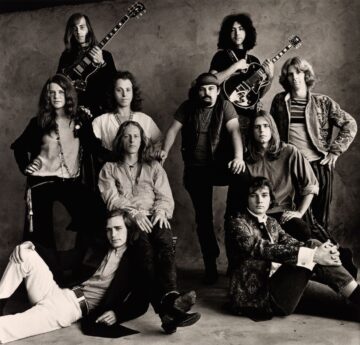
Originally published in the Marina Times San Francisco in March 2024
Major Irving Penn Retrospective features Summer of Love Photographs
By Sharon Anderson
Irving Penn’s direct, expressive portraits are celebrated among the most recognizable photographs of the 20th century. In a career that spanned 70 years, Penn was a regular contributor to Vogue magazine for more than six decades and revolutionized fashion photography in the post-war period. Exclusive to the de Young museum, this major survey of Irving Penn brings together 198 works including portraits of celebrities, cultural luminaries, laborers with the tools of their trades, abstract nudes, street scenes, nature, and of course fashion. In his most comprehensive retrospective to date, a section of the exhibit will be solely dedicated to Penn’s photographs from his 1967 trip to San Francisco.
Vogue and the Birth of a Portrait Artist
After working for a short time at Harper’s Bazaar and Saks Fifth Avenue, Penn traveled and took photographs before accepting a position in Vogue’s Art Department. As one of Vogue’s top photographers, he created a record of 20th-century cultural history in images. Woman in Chicken Hat (Lisa Fonssagrives-Penn) New York, 1949 is a classic example of Penn’s fashion photography and its keen sense of balance in composition and light. The portrait Joe Louis, February 15, 1948 shows the famous boxer in his uniform as a triangulated figure propped up in a narrow corner like sculpture. Similarly, Penn had photographed artist Marcel Duchamp and writer Truman Capote in 1948 and 1949 backed into that same corner, eyes confronting the viewer. In both his fashion photos and his representations of cultural figures, Penn presents form in a minimal style combined with the directness of the subject’s gaze. This style of photographic representation became commonplace in the 50’s and 60’s but Irving Penn popularized the approach.
The Summer of Love
In 1967, Look magazine commissioned Penn to travel to San Francisco to record the Summer of Love. While on assignment, he snapped images of Hells Angels, hippie communities and local rock bands. An expanded selection of images from San Francisco in the late 60’s during its moment at the epicenter of the countercultural movement will be given a special emphasis in the exhibit. “Penn’s images of West Coast residents capture a moment of electrifying social change, which forever altered the cultural landscape of the Bay Area,” remarked Emma Acker, Curator of American Art at the Fine Arts Museum of San Francisco and organizing curator of the exhibition.
In Rock Groups (Big Brother and the Holding Company and The Grateful Dead) from 1967, Penn looks into the faces of the “New” San Francisco. Instead of the brightly colored, psychedelic scene one might expect, the photographer instead memorializes its subjects in black and white. The group, which includes Janis Joplin and Jerry Garcia, gaze with intent into the camera with deliberate expressions lending the image a sincerity and sense of immediacy. Hells Angel (Doug) San Francisco, 1967 has the same strong sense of individuality and documentarian characteristics.
Traditional Art and Color
Though he was known for his black and white photos, Irving Penn did experiment with color. In an homage to the style of Dutch still life painters, Still Life with Watermelon, New York, 1947 is a traditional color image of a still life from the bowl of fruit in the upper register to the folded napkin and crust of bread in the foreground. Fast forward to 1986, and Mouth (For L’Oréal), New York, 1986, a cropped image of nose, and lips splashed with diagonal hues of lipstick in pinks, browns and reds exist as a nod to the style of 1980’s fashion and advertising. Also on view are his rarely seen, experimental photographs of nude workshop dancers performing American choreographer Anna Halprin’s The Bath.
The Iconic and the Everyday
Irving Penn approached photography as fine art long before the medium was recognized as such. The exhibition presents Penn’s photographs of such leading lights of the screen as Marlene Dietrich and Audrey Hepburn, renowned designers Gianni Versace and Yves Saint Laurent, architect Le Corbusier, writer Joan Didion and others. Penn lended that nuanced sense of composition and human expression to his portraits of everyday people also – tradespeople, street vendors and residents of Cuzco, Peru are seen through the egalitarian spirit of Penn’s lens so that familiar faces and strangers are equally powerful.